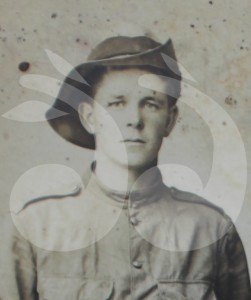Aubrey Dobson
Boer War

Aubrey Dobson of Scone. Photo courtesy of Scone and Upper Hunter Historical Society.
Aubrey was one of Scone’s first soldiers, having served in the Boer War. He was also probably one of the youngest to have seen active duty, going to Africa at just 15 years of age as a trumpeter.
In 1937 one of the instruments he used was found in a second-hand shop in Sydney and was returned to the Victoria Barracks as a war trophy, as described in the Canberra Times:
“The two instruments now in possession of the Canberra Troop were first used on active service by Trumpeter Booth (ex-Imperial) and Trumpeter Aubrey Dobson, of Scone. It is thought that Booth brought one of the instruments back to Australia. Twenty years later one of the Instruments had been discovered in a second-hand shop in Sydney and it was finally returned to Victoria Barracks.”1
There is a photo of Aubrey Dobson as a Boer War veteran from the photographic collection of the Scone and Upper Hunter Historical Society, below. The inscription on the back of the photo, by John A Smith on May 9, 1977, reads as follows:
“Boer War Veterans: This group taken by the Crown Studios of Sydney, shows three soldiers who took part in the Boer War. From left is Aubrey Dobson, who went to war when he was 15 years of age, reputed to the youngest bugler to see active service in the African War; returned home without wounds to become a Scone plumber, picture show proprietor and later amateur movie-maker. Man in centre not identified. Man at right is Jim P.Hartney, landowner and farmer of Aberdeen.” 2

BOER WAR VETERANS: Aubrey Dobson of Scone, an unknown soldier and Jim P Hartney of Aberdeen. Photo courtesy of Scone and Upper Hunter Historical Society.
First filmmaker in Scone
Aubrey Dobson was the owner of the Olympia Theatre in Scone and seems to have been the first person to have made films in the area. Aubrey was a self taught amateur cameraperson who shot on a 35mm Zeiss Ikon Camera.3
Films known to have been made by Aubrey include: The March to Freedom, Football in the Mud, various football matches including Scone v Aberdeen and Scone v Muswellbrook; Hockey Girls, Birds of Murrurundi, District Fat Cattle, Swimming, Tin Hares at Scone, Scone and District in 1921, The First Skip of Coal from Scone Colliery (Wingen) and Who’s Who in Scone.4
The first record of Aubrey’s films seems to have been The March to Freedom probably filmed in 1916 or 1917. Aubrey presented the film to the local school for preservation in 1925, but it is not known if the film still exists.
His film Scone and District in 1921 was shot when the New States Sports Meeting was held in Scone. The film included footage of Belltrees, Arden Hall, now under Glenbawn Dam, and Cliftlands. This film, along with the March to Freedom was screened in 1925 and received praise in the Scone Advocate, April 6, 1925:
“…the writer will say that the film descriptive of the Upper Hunter scenery, even the much vaunted scenic films of America, has nothing to put over better than was shown locally on Monday.”5
The only film known to still exist of Aubrey’s is “Who’s who in Scone“. The film was originally screened in 1934 during Back to Scone Week, which was to raise money for a Nurses’ Home at the Scott Memorial Hospital in memorial to Arthur Smith, the founder of the Scone Advocate.6
The film seems to have been edited together from a range of footage and depicts various people of Scone. The National Film and Sound Archive has a copy of the film and it is titled “Who’s who in Scone, Scone in the 1920’s”. While it may have screened in 1934, it is likely the footage was shot throughout the 1920’s and early 1930’s.
Aubrey regularly played the film at his Olympia Theatre until 1936, after which he donated the film to the Upper Hunter Shire Council. It was later donated to the Scone and Upper Hunter Historical Society and preserved by the Australian National Film and Sound Archive in Canberra7
Special thanks to:
- the Scone and Upper Hunter Historical Society for assistance, especially Mary Woodlands for her help in researching local films.
Footnotes:
- “Boer War Trophy”, The Canberra Times, Thursday, September 2, 1937, p.3, cited on Trove, http://trove.nla.gov.au/ndp/del/article/2440440, viewed on December 17, 2013 [↩]
- Boer War Veterans, Boer War Box, 6/10, held by the Scone and Upper Hunter Historical Society, Scone. [↩]
- Heather Ashford; assisted by Mary Woodlands, “Filming in the Upper Hunter”, Moving Images and the Theatre, The Shiralee, Filming in the Upper Hunter, Scone’s Civic Theatre”, Federation Publication No.1, Published by the Scone and Upper Hunter Historical Society Incorporated, Scone, NSW, Australia, 1997, p.27 [↩]
- Heather Ashford; assisted by Mary Woodlands, “Filming in the Upper Hunter”, Moving Images and the Theatre, The Shiralee, Filming in the Upper Hunter, Scone’s Civic Theatre”, Federation Publication No.1, Published by the Scone and Upper Hunter Historical Society Incorporated, Scone, NSW, Australia, 1997, p.25 [↩]
- Heather Ashford; assisted by Mary Woodlands, “Filming in the Upper Hunter”, Moving Images and the Theatre, The Shiralee, Filming in the Upper Hunter, Scone’s Civic Theatre”, Federation Publication No.1, Published by the Scone and Upper Hunter Historical Society Incorporated, Scone, NSW, Australia, 1997, p.25 [↩]
- Heather Ashford; assisted by Mary Woodlands, “Filming in the Upper Hunter”, Moving Images and the Theatre, The Shiralee, Filming in the Upper Hunter, Scone’s Civic Theatre”, Federation Publication No.1, Published by the Scone and Upper Hunter Historical Society Incorporated, Scone, NSW, Australia, 1997, p.25,26. [↩]
- Heather Ashford; assisted by Mary Woodlands, “Filming in the Upper Hunter”, Moving Images and the Theatre, The Shiralee, Filming in the Upper Hunter, Scone’s Civic Theatre”, Federation Publication No.1, Published by the Scone and Upper Hunter Historical Society Incorporated, Scone, NSW, Australia, 1997, p.25,26. [↩]
 scone.com.au
scone.com.au